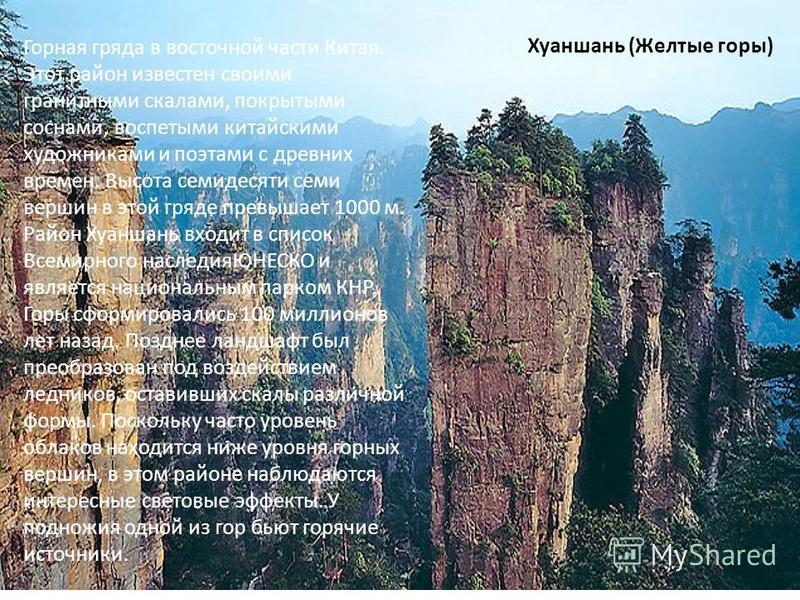Download presentation grief. Caucasus mountains. Mountains of south america
To use the preview of presentations, create yourself a Google account (account) and log into it: https://accounts.google.com
Slide captions:
mountains Geography Week Prepared by a geography teacher O.V. M OLODKINA
What are mountains? Mountains are strongly dissected parts of land, significantly, by 500 meters or more, raised above the adjacent plains. Mountains are separated from the plains either directly by the foot of the slope or by the foothills. Mountains can be linearly elongated or arched with parallel, trellised, radial, cirrus, rocker or branchy pattern of dismemberment. Distinguish highlands, midlands and lowlands.
Shape of mountains Mountains form in tectonically active areas; by origin, the mountains are divided into: tectonic, erosive, volcanic. Depending on the nature of the deformations of the earth's crust, folded, blocky and folded-blocky are distinguished among the tectonic mountains.
The place of mountains on planet earth. Mountain systems occupy 64% of the surface of Asia, 36% - North America, 25% - Europe, 22% - South America, 17% - Australia and 3% - Africa. In total, 24% of the earth's surface is mountainous. 10% of all people live in the mountains. Most of the rivers of the Earth originate in the mountains.
Forms of mountainous terrain Depending on the area occupied by the mountains, their structure and age, there are: isolated elevations of a small length, the so-called island mountains (eg, Khibiny); mountain groups; mountain ranges - large linearly elongated relief elevations, isolated or component elements of mountain countries (systems); the intersection or junction of two or more mountain ranges are referred to as mountain nodes; a mountain node may also be the center of several radially diverging ridges; massifs - areas of mountainous countries located more or less isolated and having approximately the same length and width (eg, Mont Blanc in the Alps); they are distinguished by a relatively weak dissection; they are separated from neighboring ridges of a mountainous country by wide and deep valleys; mountain systems - mountains geographically united, having a common cause of origin and having morphological unity;
mountain belts of the earth mountain belts - the largest unit in the classification of mountainous terrain, consists of several mountain systems stretched into a single (continuous or discontinuous) strip; this includes, for example, the Alpine-Himalayan mountain belt (extending from Western Europe to the southeastern tip of Asia) and the Andean-Cordillera mountain belt, stretched along the western outskirts of North and South America.
On the topic: methodological developments, presentations and summaries
KTD "Burn, burn, fire of the Olympics"
Objectives: - updating information on the XXII Olympic Winter Games; - the formation of sustainable knowledge and understanding of the values \u200b\u200bof the Olympic Movement by schoolchildren; - fostering a sense of collectivism, friendship and mutual ...
Technological map of the lesson on the subject "Music" in the 2nd grade. Section "Burn, burn clearly, so as not to go out." Theme "Folklore - folk wisdom."
This publication is a technological map of an open lesson, which consistently sets out sections of the lesson and their corresponding UUD. The lesson introduces students to folk art, on ...
Colored Mountains of China (Pink Cloud) Tourists come from all over the world to the Gansu Province of China. The main local attraction is the landscape of Denxia (Pink Cloud). It is under this name that the colored mountains of China are known throughout the world. The formation of this beauty began many millions of years ago as a result of the accumulation of a large amount of sandstone and other mineral deposits. Air and water contributed to the slow oxidation of rocks. This was the reason for such an unusual riot of colors.
Huangshan (Yellow Mountains) A mountain range in eastern China. This area is known for its granite cliffs covered with pine trees, sung by Chinese artists and poets from ancient times. The height of seventy-seven peaks in this ridge exceeds 1000 m. The Huangshan region is included in the UNESCO World Heritage List and is a national park of the PRC. Mountains formed 100 million years ago. Later, the landscape was transformed under the influence of glaciers, leaving rocks of various shapes. Since often the level of clouds is below the level of mountain peaks, interesting lighting effects are observed in this area. At the foot of one of the mountains, hot springs hit.

Kailash This mountain is located in the west of Tibet. Millions of years ago, Mount Kailash rose along with a plateau from the bottom of the ocean, and then water and wind honed its edges, giving it a pyramidal shape. Four world religions consider Kailash a sacred place. Hindus believe that the powerful god Shiva lives on Kailash. From the point of view of Eastern cosmology, Mount Kailash is the center through which the axis of the universe passes. Kailash distinguishes a pyramidal shape with a snow cap, and the faces are oriented almost exactly to the cardinal points, its slopes intersect fantastically located cracks forming a swastika. The exact height of the peak is not determined, since the mountain "breathes" - every year its height changes by several tens of meters. It is believed that it is at the peak of Kailash that the entrance to the mysterious country of Shambhala is located.

Mount Roraima This unusual, impregnable mountain with a flat top is located in Venezuela (South America). The landscapes that open from its top are impressive, since the channels of many rivers for many kilometers are covered with crystals of quartz of different colors. And the sight of the mountain itself is breathtaking.

Grand Canyon In the north-west of Arizona is one of the most unique corners of the Earth - the Grand Canyon. The Grand Canyon is neither the largest nor the deepest in the world - it is valued for its harmonious combination of size, depth and multicolor layers of exposed rocks. This is a whole complex of canyons, waterfalls, caves, towers, ledges and ravines. Each time, the Grand Canyon looks new, and the sun and the shadows from the passing clouds make the rocks constantly change the shades of colors. The Grand Canyon is one of the most unusual places on our planet, in which four geological eras of the Earth are represented. Landslides, water and wind erosion created in the canyon the outlines of giant pagodas, pyramids, towers, fortress walls, which are a unique sight.


Bryce Canyon This amazing canyon is part of the eponymous National Park. It is located in the southwestern part of Utah. These are thousands of geological structures formed by long-term erosion under the influence of wind, water and ice. Many rocks have bizarre shapes.

Devil's Tower This mysterious mountain is located in the northeast of Wyoming (USA). Its height is 386 m. A rock was formed 65 million years ago as a result of volcanic activity, and unusual curly sides were the result of erosion of the surrounding soft rocks around more solid internal ones. According to the Native American legend, the rock was created by an evil demon, who beat a drum at its top, causing thunder and lightning. The Indians, who believed in the dark essence of the mountain and called it the Tower of the bad god, preferred not to settle nearby and bypassed it. In the twentieth century, the mystical theories of the origin of rocks were replaced by sci-fi. So, according to one version, the top is a platform for UFO landings. This version was so popular that it even embodied in Steven Spielberg's famous film “Close Encounters of the Third Degree”.

Tsingi de Bemaraha Tsingi de Bemaraha - strange mountains resembling forests, a nature reserve located about 80 kilometers from the west coast of Madagascar. Most of these mountains are ridges of limestone teeth, in the language of the Malagasy they are called "scurvy" ("to tiptoe"). The scurvy of de Bemarach is almost impenetrable mazes. The mountains of Tsingi de Bemaraha arose as a result of erosion, under the influence of acid rain and water, which for many centuries dissolved the chalk strata. Over time, this led to the formation of 30-meter limestone needles.

Hanging Rock Hanging Rock is the unofficial name for Mount Diogenes in the center of the Australian state of Victoria, near Melbourne. The height of the mountain is meters above sea level and 105 meters above the level of the surrounding terrain. Hanging Rock gained fame and popularity among tourists after the release of the mystical detective Peter Weir's "Picnic at the Hanging Rock" in 1975.

Stone Wave An amazing rock formation in Western Australia is located 340 km from the city of Perth. A granite block resembles a stone tsunami. The visible part of the rock rises above the ground to a height of about 15 meters, and its length is 110 meters. According to the hypotheses of scientists, the rock-wave appeared more than 27 million years ago. Australian aborigines noted the similarity of the stone wave with real water and believed that it was in this place that the powers of the spirits and the forces of nature were intertwined. To protect this unique mountain from natural destruction, a dam was built.

Ennedy Mountain Range in the Republic of Chad. This is a sandstone plateau with heights of up to 1450 m, surrounded by the sands of the Sahara. Numerous cave paintings left here by ancient tribes were found on the rocks of Ennedy. Ennedy is a nature reserve in the middle of the desert, where unique species of animals have been preserved: dwarf nile, gemsboks, Sahara lions.

Ben Balben This beautiful, unusual mountain is located in County Sligo, in the far northwest of Ireland. Ben Balben has a height of 527 meters and is a symbol of the county. Initially, the mountain had a high "hump", which was cut off by a creeping glacier. Ben Balben is composed of limestone rocks, its age is more than 320 million years. According to Irish legends, a huge wild boar lived on this mountain, which was killed by the hero Diarmide and buried on the Leh on Muik hill.

Cappadocia The landscape of the Cappadocia plateau in Turkey looks like the scenery for a science fiction film. An unusually beautiful landscape, located at an altitude of 1000 m above sea level, resembles the moon. Such bizarre in form of elevations formed the ancient volcanoes. From the 4th to the 13th centuries AD, people cut tunnels and lived in these rocks. Today, tourists from all over the world seek to Cappadocia to see this ancient world with their own eyes.

Prekestulen This is a gigantic cliff with a flat top - a platform measuring approximately 25 by 25 meters, located opposite the Kierag plateau in Norway. Prekestulen literally translates as "the pulpit of a preacher." The cliff rises 604 meters above the fjords, formed under the influence of glaciers about years ago.


What are mountains?
- The mountains - a positive landform raised above the plains. Mountains are dissected sections of the earth's surface with significant elevations (from several tens of meters to several kilometers).
Insert a map of your country.

Mountains of different continents
Mountains of africa
Mountains of Eurasia
Mountains of north america
Mountains of south america
Insert a picture of one of the geographic features of your country.
Mountains of australia
Mountains of antarctica
end show

Kilimanjaro
- Kilimanjaro - a mountain range in the north-east of Tanzania, the highest point in Africa above sea level - 5895m. Kilimanjaro rises above the Masai Plateau, which is located at an altitude of 900 meters above sea level.
In 2003, scientists concluded that molten lava is just 400 meters under the crater of Kibo's main peak . Although no other activity is predicted, apart from the current gas emissions, there are concerns that the volcano may collapse, leading to a major eruption.
Insert a picture illustrating a season in your country.


Chomolungma
- Chomolungma - the highest peak of the globe, according to various sources, from 8844 to 8852 m. It is located in the Himalayas. Located on the border of Nepal and China, the peak itself lies on the territory of China. It has the shape of a pyramid. The southern slope is steeper. Glaciers flow down from the massif in all directions, ending at an altitude of about 5 thousand m. On the southern slope and edges of the pyramid, snow and firn are not kept, as a result of which they are exposed.
Insert a picture of an animal and or plant found in your country.


McKinley
- McKinley - Two-headed mountain in Alaska, the highest mountain of North America. Located in the center of Denali National Park. In the period of Russian colonization of Alaska it was simply called - Big Mountain.
Relative height - 6138 m.
Insert a picture illustrating a custom or tradition here.


Aconcagua
- Aconcagua - The world's highest extinct volcano. Height 6962 m. Is highest point American continent, South America, western and southern hemispheres.

Insert a picture of the head leader of your country.

Kosciuszko
- Kosciuszko - the highest peak of the Australian continent. Height 2228 m. Located in the Australian Alps. The first person to climb to its peak was Pole Pavel Edmund Strzielcki, who gave grief a name in honor of the Polish-American military leader Tadeusz Kosciuszko .





